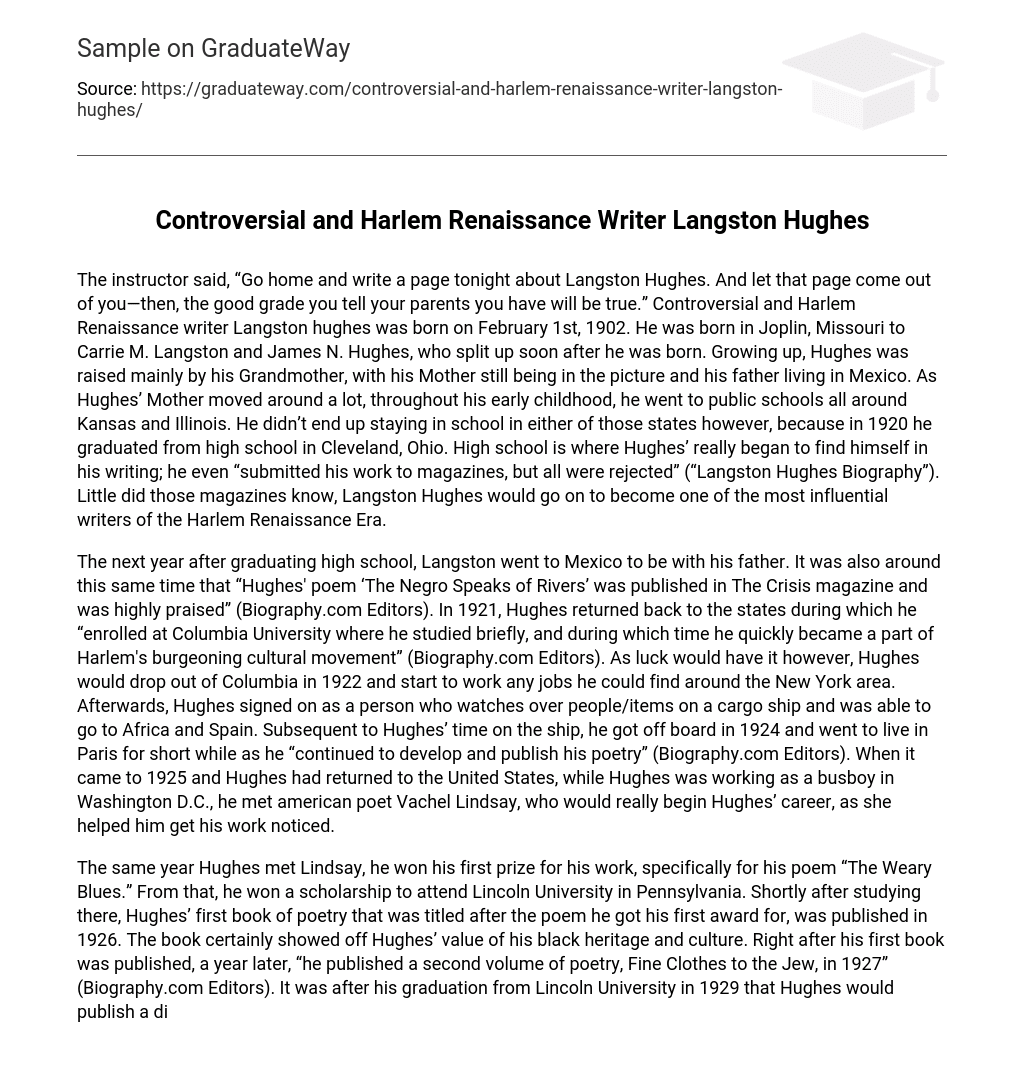The instructor said, “Go home and write a page tonight about Langston Hughes. And let that page come out of you—then, the good grade you tell your parents you have will be true.” Controversial and Harlem Renaissance writer Langston hughes was born on February 1st, 1902. He was born in Joplin, Missouri to Carrie M. Langston and James N. Hughes, who split up soon after he was born. Growing up, Hughes was raised mainly by his Grandmother, with his Mother still being in the picture and his father living in Mexico. As Hughes’ Mother moved around a lot, throughout his early childhood, he went to public schools all around Kansas and Illinois. He didn’t end up staying in school in either of those states however, because in 1920 he graduated from high school in Cleveland, Ohio. High school is where Hughes’ really began to find himself in his writing; he even “submitted his work to magazines, but all were rejected” (“Langston Hughes Biography”). Little did those magazines know, Langston Hughes would go on to become one of the most influential writers of the Harlem Renaissance Era.
The next year after graduating high school, Langston went to Mexico to be with his father. It was also around this same time that “Hughes’ poem ‘The Negro Speaks of Rivers’ was published in The Crisis magazine and was highly praised” (Biography.com Editors). In 1921, Hughes returned back to the states during which he “enrolled at Columbia University where he studied briefly, and during which time he quickly became a part of Harlem’s burgeoning cultural movement” (Biography.com Editors). As luck would have it however, Hughes would drop out of Columbia in 1922 and start to work any jobs he could find around the New York area. Afterwards, Hughes signed on as a person who watches over people/items on a cargo ship and was able to go to Africa and Spain. Subsequent to Hughes’ time on the ship, he got off board in 1924 and went to live in Paris for short while as he “continued to develop and publish his poetry” (Biography.com Editors). When it came to 1925 and Hughes had returned to the United States, while Hughes was working as a busboy in Washington D.C., he met american poet Vachel Lindsay, who would really begin Hughes’ career, as she helped him get his work noticed.
The same year Hughes met Lindsay, he won his first prize for his work, specifically for his poem “The Weary Blues.” From that, he won a scholarship to attend Lincoln University in Pennsylvania. Shortly after studying there, Hughes’ first book of poetry that was titled after the poem he got his first award for, was published in 1926. The book certainly showed off Hughes’ value of his black heritage and culture. Right after his first book was published, a year later, “he published a second volume of poetry, Fine Clothes to the Jew, in 1927” (Biography.com Editors). It was after his graduation from Lincoln University in 1929 that Hughes would publish a different kind of a work: a novel called Not Without Laughter. His novel was so successful in fact, that it was at this time Hughes realized “he could make a living as a writer” (Biography.com Editors).
For the next thirty or so years, Hughes would write hundreds more works, including much more poetry and his first book of short stories titled, The Ways of White Folks. It was also within this time period that Hughes would publish one of his most famous poems, “Let America Be America Again” that spun the idea of how far away the american dream was for the lower class. Additionally, in 1937, “he served as a war correspondent for several American newspapers during the Spanish Civil War” (Biography.com Editors). He then went on to publish his autobiography titled The Big Sea and began to take part in a newspaper column where he would address racial issues, among other topics. After helping to contribute lyrics for a Broadway musical titled Street Scene in the late 1940s, its success gave “Hughes enough money that he was finally able to buy a house in Harlem” (Biography.com Editors). In 1951, Hughes published another widely known poem of his: “Harlem (‘What happens to a dream deferred?’)” that talked about african americans and the american dream. Through the 1950s to the 1960s, Hughes would publish a considerable amount of more of his work, until passing away on May 22nd, 1967. It would be in “Polyclinic Hospital at the age of 65” that Hughes would die of issues with prostate cancer (The New York Times). Hughes left behind his many works and his Harlem home that “received New York City Landmark status in 1981 and was added to the National Register of Places in 1982” (Biography.com Editors). While gone, Hughes has never been forgotten in the minds of America’s writers, as he was one of the most influential writers of his time.





